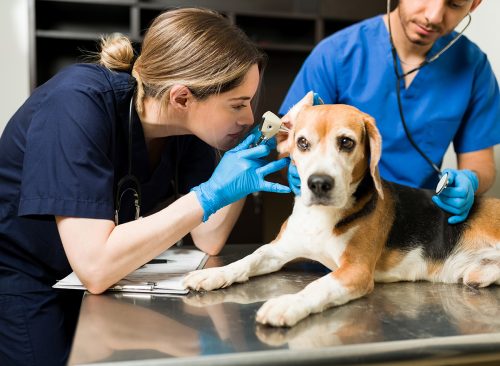11 Ways Your Dog Makes You Sick
There are lots of health benefits of being a dog owner, but a few risks

There is no question that dogs positively affect the lives of their owners. While there are many science-backed mental and physical health benefits of being a dog owner, there are some downsides as well. "Although dogs can be beneficial to the health and wellbeing of their owners, people should be aware that dogs of any age, including puppies, can sometimes carry harmful germs that can make people sick," says the CDC. These germs from Fido can cause a variety of illnesses, from minor skin infections to serious illnesses. Here are ways your dog makes you sick, according to the health organization.

Brucellosis, a bacterial disease caused by contact with infected animals and contaminated animal products like raw milk, can spread to humans if a pet is infected and a human comes into contact with them. "Most dogs infected with brucellosis show no signs of illness," the CDC says. Brucellosis in dogs can lead to infertility, abortions, infections of the reproductive organs, and, in very bad cases, an infection of the spinal bones and discs called diskospondylitis, or inflammation in the eye or brain. When humans are infected, they usually become sick within 6-8 weeks of exposure. "Sick people will have flu-like symptoms that last 2-4 weeks. Sometimes, brucellosis can become a chronic illness that can be difficult to treat. Occasionally, brucellosis can affect reproductive organs and cause miscarriage in pregnant women," the CDC says.

Campylobacter are bacteria that can make people and animals sick with a disease called campylobacteriosis, the CDC says. They spread through the feces (poop) of infected animals, contaminated food or water, or the environment, usually when people don't wash their hands after touching an infected animal. Dogs and puppies infected with Campylobacter might show no signs of infection, or they can have diarrhea. "People can have diarrhea (often bloody), fever, and abdominal cramps. The diarrhea may be accompanied by nausea and vomiting. Symptoms usually start within 2–5 days after infection and last about one week," the CDC says.

Capnocytophaga, a common type of bacteria that usually lives in the mouths of dogs and cats, won't make your pets sick, but if it spreads to you (through bites, scratches, or close contact with a dog or cat that is infected), you could become sick. "People may start to show symptoms within 1-14 days after infection with Capnocytophaga," says the CDC. Symptoms include blisters, swelling, redness, or pain around the area of the bite, fever, diarrhea, vomiting, headache, and muscle or joint pain. In rare cases, serious complications can occur, including sepsis (a blood infection), gangrene, or kidney failure.

Cryptosporidiosis, a parasitic disease caused by the germ Cryptosporidium (or Crypto for short), is spread by swallowing poop from an infected person or animal. Many animals who carry the parasite show no symptoms. "If dogs are affected by the parasite, they will typically have watery diarrhea," says the CDC. Symptoms in people include profuse, watery diarrhea with cramping, abdominal pain, vomiting, and nausea, and typically resolve within 1–2 weeks.

The flea tapeworm is a parasite spread to dogs, as well as cats and people, through the ingestion of infected fleas, explains the CDC. "The tapeworm spreads when a dog or person swallows an infected flea. Dogs may swallow fleas when grooming. Treating flea infestations and using routine flea preventatives can help prevent infection," they add. Tapeworms are usually not harmful to dogs and typically don't cause illness, but can sometimes be detected by finding rice-like segments of the tapeworm moving near the dog's anus or in fresh poop. "If a dog is heavily infected, it may lose weight or have gastrointestinal issues. Sometimes, an infected dog will "scoot" or drag its bottom across the ground to help relieve irritation," they say. Luckily, dipylidium infection is rare in people and usually doesn't cause any symptoms. And similar to dogs, sometimes the infection can be detected by finding those same "rice-like" segments near a human's anus.

Echinococcosis, a parasitic disease caused by infection with tiny Echinococcus tapeworms, is a rare but serious infection that occurs after dogs shed eggs in their poop, and it spreads to people via contaminated food or water. "People can be infected with Echinococcus larvae, the immature stage of the tapeworm that causes cysts in body organs," says the CDC. Unfortunately, dogs rarely show signs of disease, and it is possible to be infected and have no signs of illness. If they are infected with a large number of tapeworms, they can have mild diarrhea, a variable appetite, a shaggy coat, or irritability. "Although Echinococcus larvae can invade many different organs of the body, most people who are infected with the disease may not have any symptoms of illness for years," says the CDC. "The rate at which symptoms appear depends on where the cyst is located. Symptoms start when the slow-growing cysts become large enough to press on the organs they have invaded or when the cysts rupture. The cysts grow slowly in several different organs of the body, most commonly the liver and lungs."

Giardia, a parasite found on surfaces or in water, food, or soil that has been contaminated by poop of an infected person or animal, including dogs, spreads through "swallowing microscopic poop containing the parasite following contact with an infected person or animal or by drinking water or eating food that has been contaminated with poop from infected people or animals, including dogs," says the CDC. Dogs with Giardia may have diarrhea, greasy stools, or become dehydrated, while people may experience diarrhea, gas, abdominal discomfort, nausea, and vomiting.

Hookworms, tiny worms that can spread through contact with contaminated soil or sand, can infect people who are walking barefoot, kneeling, or sitting on ground that is contaminated with the poop of infected animals. In contrast, dogs can be infected by hookworms penetrating their skin or ingesting the parasite from the environment. "Young puppies are most often affected by hookworm and might have dark, bloody stool, weight loss, and anemia. Severe infections in some puppies can lead to death," the CDC says. "People with dog hookworm infection can experience an itchy reaction, and a red squiggly line may appear where the parasite larvae migrated under the skin. Unlike human hookworms, dog hookworms don't survive in an infected person, so symptoms typically resolve within 4-6 weeks without medical treatment. Rarely, the hookworm can migrate to the intestines to cause inflammation in the intestines. These infections are treated with medication to kill the hookworm (anthelmintics)," they say.

Leptospirosis, a bacterial disease affecting people and animals, can be carried in urine. "The bacteria that cause leptospirosis spread through the urine of infected animals, which can get into water or soil and survive there for weeks to months," says the CDC. People then get infected through contact with urine or other body fluids (except saliva) from infected animals or through contact with water, soil, or other materials (such as animal bedding) contaminated with urine from infected animals. People with leptospirosis might not have any symptoms. However, those who do will usually become sick within 2 days to 4 weeks of exposure and can have high fever, headache, chills, muscle aches, vomiting, jaundice, conjunctivitis (red eyes), abdominal pain, diarrhea, or a rash. "A small number of people with leptospirosis can have more severe disease, such as liver and kidney failure, hemorrhagic pneumonia, and even death. Early treatment with appropriate antibiotics is important and can reduce the duration and severity of illness," says the CDC.

Staphylococcus aureus is a common type of bacteria usually found on the skin of people and animals. When the bacteria become resistant to antibiotics, it becomes MRSA, which can cause various infections, including skin infections, pneumonia (lung infection), and other problems. It can be spread to people via animals by touching, and even dogs who aren't sick can spread it. "Dogs often don't show signs of MRSA infection, but when they do, they can develop skin, respiratory, and urinary tract infections," they say. The majority of people carrying MRSA do not have symptoms, but the most common is a skin infection. "If left untreated, MRSA can rarely spread to the lungs or bloodstream and become life-threatening."

Plague, a disease caused by Yersinia pestis, a bacteria that can cause illness in people and animals, can spread via infected fleas to dogs and cats, who can spread the disease to people. Dogs infected with Y. pestis do not always get sick, but if they do, they can develop severe illness or die from the infection, the CDC explains. "Signs of plague in dogs may include fever, low appetite, low energy, swollen lymph nodes, vomiting, and diarrhea," they say. Bubonic plague is the most common form in people. "Symptoms of bubonic plague include painful, swollen lymph nodes, sudden onset of high fever, chills, headache, and weakness. Other forms of plague, including septicemic plague and plague pneumonia, can cause more severe symptoms," the CDC adds.
RELATED: Things You Should Never Do at the Doctor's Office, Say Doctors

Tickborne infections, including Lyme disease, tularemia, ehrlichiosis, babesiosis, and others, are relatively common, as ticks can easily jump from a dog to a human. Signs of tickborne disease in dogs and other animals can vary depending on the type of infection, or they may not show any signs of illness. Symptoms of tickborne diseases in people can vary but usually include fever, chills, body aches, and sometimes a rash, the CDC says. "Some tickborne diseases can be very serious and even deadly."














